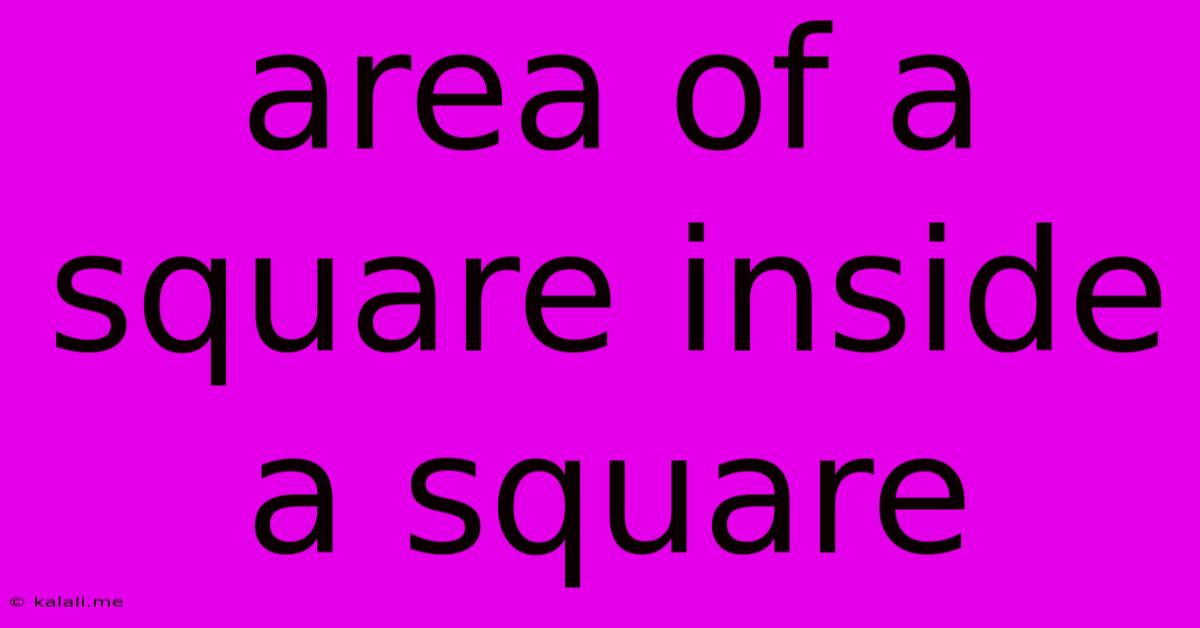Area Of A Square Inside A Square
Kalali
May 19, 2025 · 3 min read

Table of Contents
Calculating the Area of a Square Inside a Square: A Comprehensive Guide
Finding the area of a square is straightforward, but what happens when you have a smaller square nestled perfectly inside a larger one? This seemingly simple geometry problem offers a surprising number of variations and can be a great exercise in applying fundamental geometric principles. This article will explore different scenarios and provide you with the formulas and methods to accurately calculate the area of the inner square.
Understanding the Problem
The core challenge lies in determining the relationship between the inner and outer squares. This relationship can be defined in several ways, most commonly through:
- Side Lengths: Knowing the side length of the larger square and the smaller square directly allows for calculating their respective areas.
- Diagonal of the Inner Square: The diagonal of the inner square can be related to the side length of the outer square, particularly in specific configurations.
- Relationship between Areas: Sometimes the problem provides the area of the outer square and the relationship (e.g., ratio) between the areas of the inner and outer squares.
Scenario 1: Side Lengths are Known
This is the most straightforward case. Let's say:
- A represents the side length of the larger square.
- a represents the side length of the smaller square.
The area of the larger square (Area<sub>L</sub>) is simply A². The area of the smaller square (Area<sub>S</sub>) is a².
Example: If A = 10 cm and a = 5 cm, then Area<sub>L</sub> = 100 cm² and Area<sub>S</sub> = 25 cm².
Scenario 2: Diagonal of the Inner Square is Known
If the diagonal of the inner square (d) is known, and its relationship to the outer square is defined, we can use the Pythagorean theorem. However, this requires additional information about how the inner square is positioned within the outer square. For instance, the inner square might be positioned with its vertices touching the midpoints of the sides of the outer square. In this case, the diagonal of the inner square is equal to the side length of the outer square.
Scenario 3: Relationship Between Areas is Known
Suppose we know the area of the larger square (Area<sub>L</sub>) and the ratio between the areas of the inner and outer squares. Let's say the ratio is 'r':
Area<sub>S</sub> = r * Area<sub>L</sub>
Then, the area of the smaller square can be directly calculated.
Scenario 4: Inner Square Inscribed within the Outer Square
This is a common scenario in geometry problems. Imagine the smaller square perfectly nestled within the larger square, touching its sides. If we know the side length of the outer square (A), we need additional information, such as the angle formed by the vertices of the inner square and the corners of the outer square or the distance from the center of the outer square to the vertices of the inner square, to solve for the area of the inner square. This often involves trigonometry or more advanced geometric principles.
Conclusion
Determining the area of a square inside a square requires a careful understanding of the provided information and the relationship between the two squares. While calculating the area of a single square is simple, the added layer of a nested square introduces complexity that necessitates a clear understanding of geometric principles and problem-solving strategies. By carefully analyzing the given information and applying the appropriate formulas and techniques, you can accurately determine the area of the inner square. Remember to always clearly define the variables and the relationships between the dimensions of the squares to avoid errors.
Latest Posts
Latest Posts
-
The Quality Of Mercy Is Not
May 19, 2025
-
How To Attach Skirting Boards Without Nails
May 19, 2025
-
I Look Forward To Talk To You
May 19, 2025
-
Looking Forward To Speaking To You Or With You
May 19, 2025
-
How To Strip Paint Off Deck
May 19, 2025
Related Post
Thank you for visiting our website which covers about Area Of A Square Inside A Square . We hope the information provided has been useful to you. Feel free to contact us if you have any questions or need further assistance. See you next time and don't miss to bookmark.